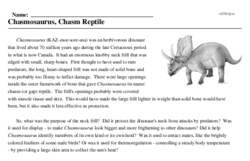Chasmosaurus, Chasm Reptile
Chasmosaurus (KAZ-moe-sore-uss) was an herbivorous dinosaur that lived about 70 million years ago during the late Cretaceous period in what is now Canada. It had an enormous knobby neck frill that was edged with small, sharp bones. First thought to have used to ram predators, the long, heart-shaped frill was not made of solid bone and was probably too flimsy to inflict damage. There were large openings inside the outer framework of bone that gave Chasmosaurus its name: chasm (or gap) reptile. The frill's openings probably were covered with muscle tissue and skin. This would have made the large frill lighter in weight than solid bone would have been, but it also made it less effective as protection.
So, what was the purpose of the neck frill? Did it protect the dinosaur's neck from attacks by predators? Was it used for display - to make Chasmosaurus look bigger and more frightening to other dinosaurs? Did it help Chasmosaurus identify members of its own kind or its own herd? Was it used to attract mates, like the brightly colored feathers of some male birds? Or was it used for thermoregulation - controlling a steady body temperature - by providing a large skin area to collect the sun's heat?
When the first fossils of Chasmosaurus were found, there seemed to be two basic kinds. One had shorter facial horns than the other, but the fossils of both were found together in the same rocks. One idea is that these two kinds were males and females of the same species. Many of today's animals that have horns show distinct differences between males and females of the same species.




